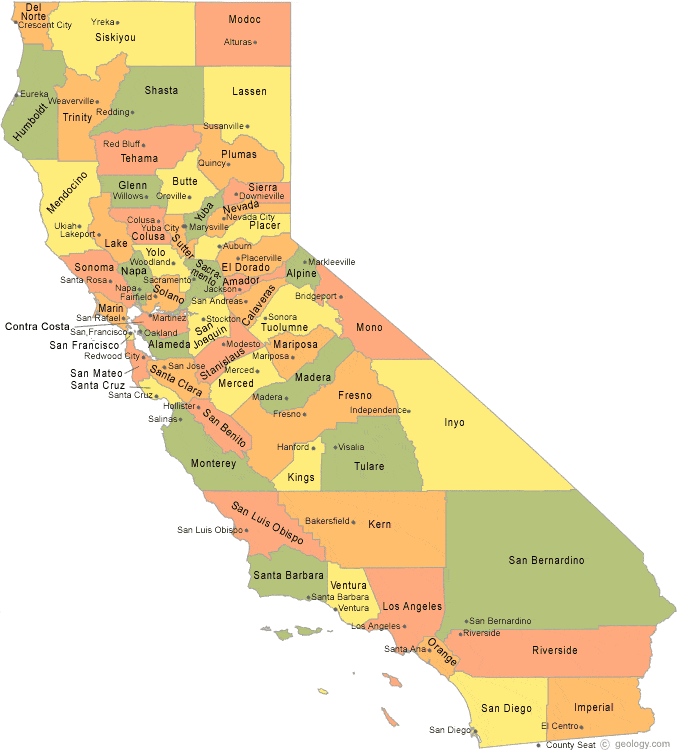California Counties Guide – How Many and What to See in Each

Have you ever wondered how many counties are in California? You’re not alone. Be it for research, a road-trip map, or pub-quiz glory, the magic figure 58 always surfaces, yetthose two digitsis just the first layer of a deeper tale.
The Golden State’s 58 counties create an incredibly diverse mosaic: sun-drenched coastal hubs, pine-covered mountain regions, fruit-laden interior valleys, and thriving tech metropolises. Each county carries its own story, shaped by gold-rush dreams, cutting-edge innovation, and relentless population booms.
In the sections ahead, we’ll unpack why California ended up with 58 counties, the services counties deliver day-to-day, and the outliers that set fascinating records. When we’re done, you’ll know the facts—and be ready to ace any quiz with confidence.
County-Making in Early California
On statehood day in 1850, the map looked nothing like today’s. An unprecedented population boom compelled legislators to carve out new counties. Before the century turned, the count had ballooned to 53 counties, and by 1907 the remaining gaps were closed, locking in the canonical figure of 58.
Assembly journals reveal that most new counties stemmed from three major pressures:
- Sheer distance left settlers days from the nearest courthouse.
- Economic clashes splitting river towns from hinterlands triggered secession campaigns.
- Language and immigrant communities wanted self-rule.
Within a single generation, the political map stabilised. Right now, every effort to create county #59 stalls, causing commentators to dub the era of county creation decisively over.
Landscape and Climate Diversity Across California Counties
Plot a route from foggy Crescent City to the date groves of Coachella, and you’ll cross dozens of ecosystems. Coastal counties benefit from fog-cooled summers, while basin counties in the Central Valley record triple-digit heat.
- Mountain counties such as Placer, Nevada, and Alpine store California’s snowpack.
- Delta counties fight subsidence but export produce worldwide.
- Island counties like Los Angeles manage marine sanctuaries.
That geographic spread underpins why no two counties share identical economies. Topography dictates everything from wage levels to weekend hobbies.
Behind the Scenes at the County Level
Within the state’s tiered system, municipalities handle zoning, but counties shoulder the bread-and-butter functions that hold civilisation together. From birth to death—vital records, coroner reports, property deeds—all reside at the county clerk or recorder.
County law-enforcement offices patrol vast rural stretches, while superior courts hear felony cases. Public-health branches coordinate Medi-Cal. Tax-allocation showdowns spark long agenda nights.
Spotlight: Los Angeles County’s Scale
Los Angeles County alone employs 100 000+ workers, illustrating how flexible county structures can be. Uniformity would never work when land areas shift from 47 to 20 000 sq mi.
In the end, county halls act as middle managers between Capitol and curbside. Grasping their portfolio helps residents demand accountability.
Population, Economy, and Record-Holding Counties
Home to over 39 M souls, but the headcount collects in dramatic clumps. Los Angeles County alone packs nearly 25 %. On click here the flip side, tiny Alpine County could fit its voters into a high-school gym.
- Top headcount: County of Los Angeles
- Least populous: County of Alpine
- Biggest footprint: San Bernardino County
- Tightest borders: City & County of SF
Fiscal bandwidth mirrors population spread. Tech-centric jurisdictions boast per-capita GDP rivaling small nations, while Central Valley breadbaskets battle mechanisation and drought cycles. These fiscal contrasts fuels housing affordability crises every decade.
Memorising these recordsmakes relocation plans simpler: county metrics shape property taxes and commute times.
Touching All Counties in One Journey
Adventure-hungry drivers, setting foot in each CA county ranks as a top geo-challenge. A popular itinerary begins in San Diego, follows Highway 101 past surf towns, swings through Big Sur, then threads through nut groves and tomato fields, before climbing into the high Sierra for ghost towns and mining museums.
Regional Mini-Loops
- Southern Swing – San Diego to Santa Barbara; 10 counties in four days.
- Crop-Belt Drive – Grapes to rice paddies; flat-land express.
- Shasta & Siskiyou Turn – evergreen corridors; hidden hot springs.
Cap off the circuit in El Centro, after two thousand kilometres of asphalt. After that, you can confidently claim you know “how many counties California has”—because your copyright stamps prove it!
California County FAQ
Below you’ll find concise answers to the most common county-related queries.
How many counties does California have?
Government documents list 58 counties—a total locked in for over a century. Regardless of the source—be it Sacramento archives or federal census data: 58 in all.
Most populous California county?
LA County leads by a wide margin, housing roughly one in four Californians. From Hollywood to high tech, a mix of industries continues to fuel steady inflow.
Least populous California county?
Tiny Alpine County sits at the bottom of the population chart, often cited at just about a thousand souls. Location along rugged mountain corridors naturally restricts settlement, making it a haven for solitude seekers.
What is California’s biggest county geographically?
San Bernardino County spans the most ground stretching more than 20 000 square miles. Its sheer scale means climate zones shift from alpine snow to Mojave heat within county lines.
Why does California have exactly 58 counties?
Gold-rush politics, rail expansion, and farmland disputes carved today’s boundaries, ending when Imperial County formed in 1907. Since then, proposals to add a 59th county have surfaced but never cleared the Legislature.
Is it possible to form a 59th county?
On paper, state statutes permit county formation, yet practical barriers loom large. A break-off region must gather local signatures, win a majority vote in each affected county, and secure legislative approval. Consequently, boundaries have frozen for over a century.
Why are counties important to everyday life?
Behind the scenes, counties keep daily life functioning: foster care, libraries, building permits, and superior courts. Without county infrastructure, everything from jury duty to restaurant inspections would grind to a halt.